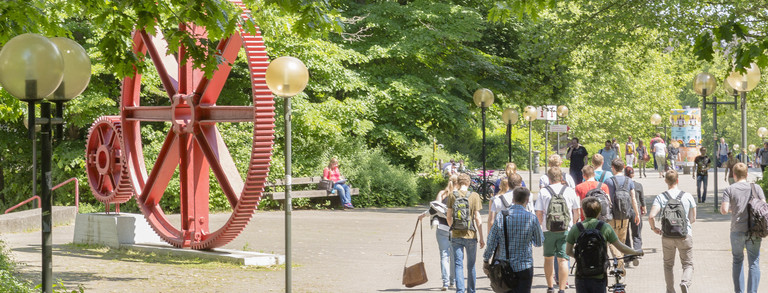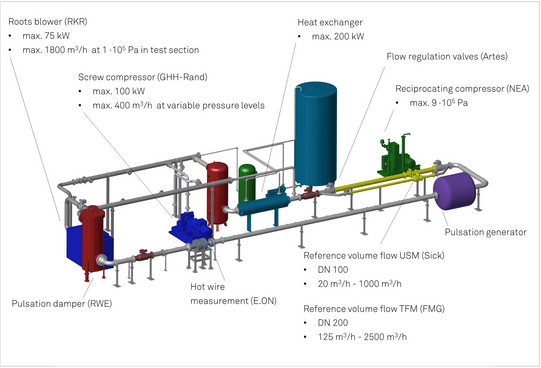Closed loop air test rig
The closed loop air test rig is useable for different examinations of steady-state and transient problems in fluid mechanics. This could be afforded by an adaptable layout and a conceptual design.
The test rig is built up of a drive unit, a pressure regulation and a heat exchanger to achieve constant operating conditions, a section of flow measurements and a pulsation generator - especially designed for the test rig – with the connected section of measurements for different investigations.
The section of measurements has a nominal diameter of DN200. There are two positive displacement machines for different operating conditions actually installed in the test rig. The actually installed screw compressor allows flow rates up to 500 m³/h within absolute pressures up to 8 bar. The also installed roots compressor is able to realize flow rates up to 2000 m³/h next to the ambient pressure. The pumped fluid is air. An expansion of the operating range with regard to flow rate and pressure is possible, according to the upcoming research projects.
Realization, specifications and the characteristics of components and assemblies are illustrated below.
- Drive unit
The drive unit actually consists of a GHH screw compressor with an engine power of 100 kW at its peak and a RKR roots compressor with a maximal power of 75 kW. Pulsation damping tanks haven been installed, to minimize the generic pressure pulsation of positive displacement pumps which are affecting the measurement section, as well for suction side as for pressure side. The accumulation piping mounted to suction and pressure side allows the attachment from one through to three turbo and displacement machines, so the rig is able to work either discrete or parallel. The choice and installation of additional machines will be considered by upcoming research projects.
- p-T-regulation
To realize examinations at different pressures the circuit avails statical loading by using a two-stage NEA reciprocating compressor. Besides pressure regulation the temperature is regulated by a counter flow heat exchanger. Its designed with tube bundles and supplied by a water pump with cooling water from a separate reservoir. The central regulation through the measurement station affords constant operating conditions during particular test series.
- Volume flow measurement
To measure the operating volume flow there are two parallel measuring sections integrated in the circuit. Actually the volume flow is determined by an ultrasonic flowmeter. At the same time a turbine flowmeter should be installed into the spare pipe. For the conversion into the nominal volume flow, the pressure and temperature is measured at the flowmeters.
- Piping system
The pipe system has a nominal diameter of DN 200. Only particular junctions like the reference measurement section have slightly different nominal diameters. Furthermore all pipes, tanks and attachments are designed and licensed for a maximal nominal pressure of 16 bar (PN 16).
Besides the use of operating units and the control elements, the pulsation generator especially, as well as the test section including corresponding measurement technology have to be emphasized as the main research unit of the closed loop air test rig.
- Pulsation generator
The pulsation generator is composed as a vessel which is utilized as a snubber to prevent the expansion of the generated pulsation into the reference measurement section. There are two segmented orifices attached to the displacement flange which is directed to the test measurement section. One of these orifices is fixed while the other one is able to rotate driven by a step motor. So there is an ability to induce transient flow fields, based on the resulting diversified outlet geometry.
- Measuring section
The measuring section with a length of 18 m admits the installation and investigation of different test objects. For a detailed exploration of effects in fluid mechanics the measuring section offers numerous gauge connections to place different sensors.
- Measurement technique
In addition to the acquisition of stock measurement parameters like pressure, temperature and volume flow the local flow rates can be measured by using hot wire technology. For detailed investigations a rotatable traverse allows to detect the three dimensional velocity profile of the whole cross section.
Support
Donations in kind from EON, RWE, NEA, GHH-Rand, Artes & Sick


